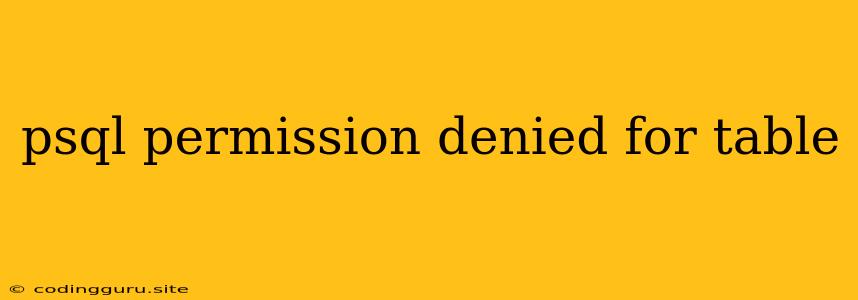The "psql permission denied for table" Error: A Comprehensive Guide
Encountering the dreaded "psql permission denied for table" error can be a frustrating experience for PostgreSQL users. This error signifies that your current PostgreSQL user doesn't have the necessary privileges to access or modify a specific table in the database. This can occur for a variety of reasons, ranging from incorrect user permissions to improper database setup. Let's delve into the common scenarios and how to troubleshoot this pesky error.
Common Causes
- Insufficient Privileges: The most likely culprit is that your current PostgreSQL user lacks the essential permissions to interact with the targeted table.
- Incorrect Ownership: The table might be owned by a different user, and your current user doesn't have the required permissions to access it.
- Database Access Restrictions: The database itself could have specific access limitations restricting your user's ability to access the table.
Troubleshooting Steps
-
Verify User Permissions: Begin by verifying the permissions associated with your PostgreSQL user. Here's how:
-
Log in to psql: Open a terminal or command prompt and log in to your PostgreSQL instance as your user.
-
Query Permissions: Use the following command to display the privileges granted to your user:
\dp -
Analyze Results: Carefully examine the output. Ensure that your user has the necessary permissions to select, insert, update, delete, truncate, and drop the table in question. If any of these privileges are missing, you'll need to grant them.
-
-
Check Table Ownership: Determine who owns the table you're trying to access. Use this query to identify the table owner:
SELECT tableowner FROM pg_tables WHERE tablename = 'your_table_name';- If the table owner differs from your user: You'll need to either change the table owner or grant your user specific privileges for the table.
-
Inspect Database Access Controls: If the table ownership is correct and your user has the required privileges, the issue might lie within the database access controls.
-
Use the
GRANTcommand: If your user lacks the desired privileges, use theGRANTcommand to grant them:GRANT SELECT, INSERT, UPDATE, DELETE ON your_table_name TO your_user_name;Replace
your_table_nameandyour_user_namewith the appropriate values. -
Check Database-Level Permissions: If you suspect database-level restrictions, examine the database permissions using the
\ddcommand.
-
-
Review Database Configuration: Explore the PostgreSQL configuration file (
postgresql.conf) for any restrictions that might be affecting access to the table. -
Utilize the
REASSIGN OWNED BYCommand: In some situations, you might need to change the ownership of the table. Use theREASSIGN OWNED BYcommand to transfer ownership:ALTER TABLE your_table_name OWNER TO your_user_name;Caution: This will transfer ownership of all objects associated with the table to the new owner. Use it with care.
Practical Examples
-
Scenario: You're trying to insert data into a table, but you receive the "psql permission denied for table" error.
- Solution: Verify your user has
INSERTprivileges on the table. If not, grant them using theGRANT INSERT ON your_table_name TO your_user_namecommand.
- Solution: Verify your user has
-
Scenario: You need to update data in a table, but you encounter the same error.
- Solution: Ensure your user has the
UPDATEprivilege for the table. Grant it withGRANT UPDATE ON your_table_name TO your_user_name.
- Solution: Ensure your user has the
Prevention and Best Practices
- Establish Clear Permissions: Establish a system of well-defined permissions for different PostgreSQL users to prevent unauthorized access and maintain security.
- Grant Privileges with Care: Avoid granting excessive permissions to users. Grant only the necessary privileges for their roles.
- Document User Roles and Privileges: Maintain thorough documentation of user roles, permissions, and the rationale behind them.
- Regularly Review Permissions: Periodically review and update user permissions to ensure they remain relevant and secure.
Conclusion
The "psql permission denied for table" error is often a symptom of insufficient privileges or incorrect ownership. By diligently following the steps outlined above, you can diagnose and resolve this common PostgreSQL issue. Remember to prioritize security and best practices when managing database permissions. This will safeguard your database from unauthorized access and ensure its integrity.
